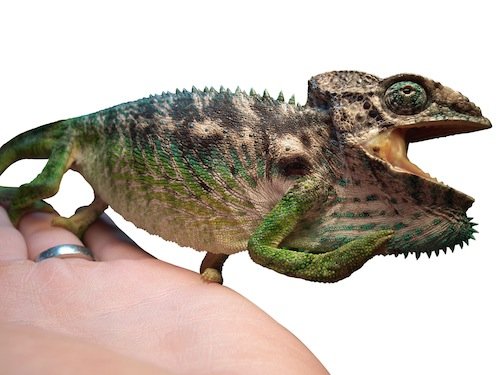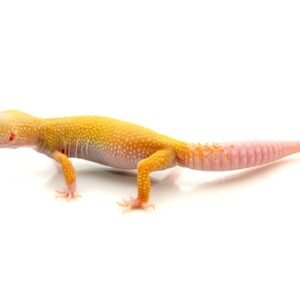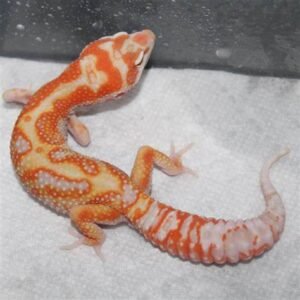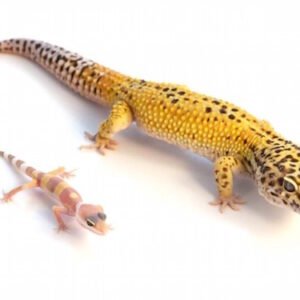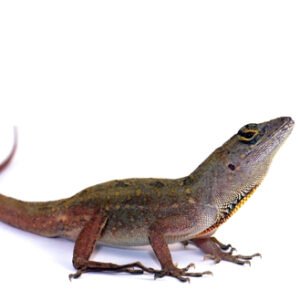Understanding the Giant Spiny Chameleon
The giant spiny chameleon, scientifically known as Furcifer oustaleti, is an extraordinary reptile native to the lush forests and jungles of Madagascar. These creatures thrive in humid environments that provide ample foliage and hiding spots, which are essential for their survival and natural behaviors. In the wild, giant spiny chameleons exhibit a unique morphology characterized by distinct spines that run along their bodies and heads, offering them an impressive camouflage against predators. Furthermore, their remarkable color-changing abilities allow them to communicate with one another, regulate their body temperature, and blend into their surroundings.
Their diet in the wild predominantly consists of insects, such as crickets and grasshoppers, which provide essential nutrients. When considering these chameleons as pets, it is crucial to replicate their natural diet as closely as possible, incorporating a variety of live insects and supplementing with vitamins and minerals to ensure their health. Moreover, understanding their care requirements is vital, particularly concerning humidity and temperature. Giant spiny chameleons require a consistent humidity level of around 60-80%, alongside a temperature gradient that allows them to bask in warmth as needed.
Behaviorally, giant spiny chameleons are often solitary creatures, displaying a preference for their own space, particularly during feeding or resting times. They may exhibit some territorial tendencies, especially males during mating seasons. It is important for pet owners to observe their temperament and provide suitable habitats that allow for retreat, as stress can lead to health complications in captivity. Proper care, which includes maintaining the correct environment, feeding regimen, and understanding their behavioral quirks, fosters a healthy relationship with these captivating reptiles. As potential pet owners consider adding a giant spiny chameleon to their home, grasping these fundamental aspects ensures a successful and fulfilling ownership experience.
Caring for Your Giant Spiny Chameleon: Tips and Best Practices
Owners of giant spiny chameleons must prioritize creating an optimal habitat that closely resembles their natural environment. Setting up a proper enclosure is crucial; it should be spacious enough to accommodate climbing, as these chameleons are arboreal. A well-ventilated terrarium, measuring at least 4 feet tall and 2 feet wide, allows for vertical space that encourages natural behaviors. Inside the enclosure, various branches should be arranged to promote climbing and basking. Additionally, incorporating live plants such as pothos or ficus can enhance the ambiance while providing hiding spots and humidity.
Proper UV lighting is another essential element to consider, as giant spiny chameleons require exposure to UVA and UVB rays for optimal health. The UVB light should be positioned correctly to cover two-thirds of the enclosure, and it’s important to replace these bulbs every six months to ensure their effectiveness. Alongside UV lighting, providing a heat source, such as a basking lamp, allows the lizard to regulate its body temperature. The basking area should ideally reach temperatures of 85-95°F, while the cooler side of the habitat should remain around 70-75°F.
Feeding practices are integral to maintaining the health of your giant spiny chameleon. A varied diet should primarily consist of gut-loaded insects, such as crickets, roaches, and mealworms. Gut-loading refers to the process of feeding these insects nutritious foods before offering them to the chameleon, ensuring that these pets receive appropriate nutrients. Vitamin supplementation should also be part of their diet, with calcium and multivitamin powders added to the insects a few times a week.
Health considerations are vital for your chameleon’s well-being. Watch for signs of stress, which may include lethargy, lack of appetite, or abnormal coloration. It’s important to recognize symptoms of common illnesses, such as respiratory issues or metabolic bone disease. Regular veterinary check-ups will aid in early detection and treatment of any health problems. Lastly, handling your giant spiny chameleon should be approached gradually to minimize stress, ultimately fostering a bond between you and your pet. Caring for a giant spiny chameleon involves commitment to their environment, diet, and overall health.

